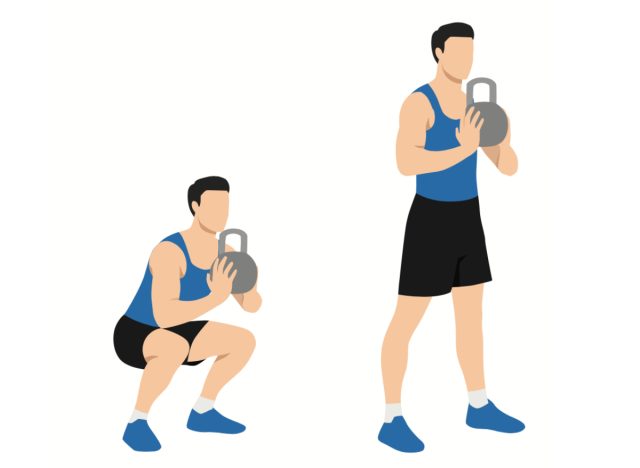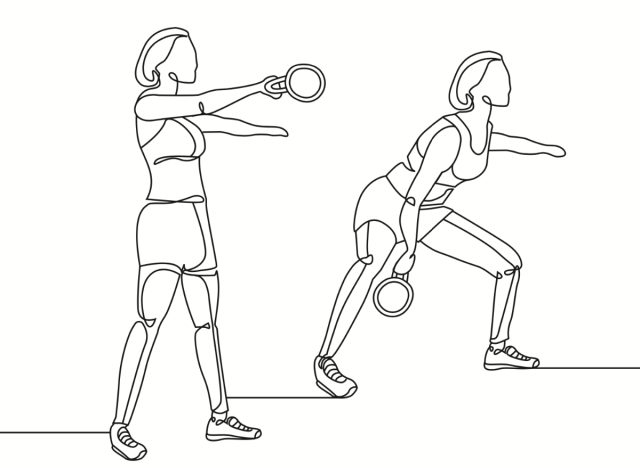The kettlebell stands out as one of the most versatile tools in any gym arsenal. The ability to turn traditional squats, deadlifts, lunges, and RDLs into dynamic muscle and strength-building movements puts kettlebells in a category of their own—especially regarding must-have pieces of home gym equipment. Kettlebell movements not only build strength and size but also demand relentless stability as you stabilize the weight throughout each rep, adding an extra layer of challenge to your workout. I put together the #1 kettlebell leg workout to build muscle and strength, so listen up.
When tackling your next leg-day session, incorporate these exercises to maximize muscle growth, enhance strength, and inject excitement into your routine. You’ll work your quads, hamstrings, glutes, and calves through various positions and movement patterns. The sets and reps mimic those proven to be backed by research for supporting strength and size in the lower body. The rest periods are fair, allowing just enough rest before cranking out your next set.
Keep reading to learn all about the #1 kettlebell leg workout to build muscle and strength. And when you’re finished, be sure to check out the 10 Best Total-Body Exercises To Look 10 Years Younger After 40.
Kettlebell Front Squats

This kettlebell leg workout to build muscle and strength kicks off with kettlebell front squats. The front rack position of the kettlebell front squat works wonders for your quads by isolating them. Add to that the requirement for core engagement to keep your torso upright throughout each repetition, and you’ve got an outstanding exercise for lower body muscle and strength development. In addition, if you’d like to incorporate two kettlebells into this squat variation, you will increase the resistance, further challenging your muscles for more significant gains.
Start by holding a kettlebell with both hands at chest level, elbows pointing to the sides, and palms facing the floor (a front rack position). Stand with your feet shoulder-width apart. Next, squeeze your core for stability, and squat by pushing your hips back and bending your knees, lowering your body while keeping your chest up and weight centered over your mid-foot. Aim to descend until your thighs are parallel to the ground. Drive through your whole foot and engage your glutes to return to the starting position. Complete three sets of eight to 12 reps with a 5-second controlled lowering to intensify the stability effect. Rest for 90 seconds between sets.
Double Kettlebell Deadlifts
The double kettlebell deadlift takes your workouts to the next level compared to its traditional counterpart. Like other hip-hinge strength exercises, it engages a wide range of muscle groups, including the hamstrings, glutes, quads, and upper and lower back, while demanding significant stabilization from your core. The double kettlebell deadlift provides an extra challenge by targeting your grip strength, making it an excellent option for building muscle and strength.
Start by positioning a kettlebell on each side of your feet while standing with a hip-width stance. Next, push your hips back and hinge forward, maintaining a nearly parallel position of your torso with the floor. Grip each kettlebell handle with a neutral grip. Focus on driving through the entire foot, pushing the floor away as you extend your knees and hips. Once you’ve fully locked out your hips, reverse the movement by pushing your hips back and hinging forward again. Lower the kettlebells back to the floor, reset your position, and repeat the exercise. Perform three sets of six to 10 reps with 90 seconds of rest between sets.
Bulgarian Split Squats
While the back squat hails as the ultimate bilateral squat, the Bulgarian split squat emerges as a premiere exercise in single-leg squats. Elevating your rear foot in this exercise intensifies the challenge on your front leg, enhancing both strength and stability while activating your quads and glutes. The elevated rear foot position also extends the range of motion for each repetition, prolonging the time under tension and leading to enhanced results.
Begin by standing with your back facing a flat-weight bench. Place one foot on the bench behind you, ensuring it’s stable and secure. With two kettlebells held at your sides, bend your front leg to descend slowly, maintaining control throughout the movement. Continue lowering your body until your front knee forms a 90-degree angle, ensuring your knee stays aligned with your ankle. Pause briefly at the bottom, then push through the heel of your front foot to return to the starting position. Perform the desired number of repetitions on one side before switching to the other leg. Complete three sets of eight to 15 reps per side with 90 seconds of rest between sets.
Single-Arm Kettlebell Swings

Fitness enthusiasts recognize the kettlebell swing and its various iterations as one of the most versatile and dynamic exercises in workouts. This dynamic movement engages multiple muscle groups, particularly emphasizing developing size, strength, endurance, and power in the posterior chain. While this workout focuses on building muscle and strength, don’t hesitate to use kettlebell swings in your HIIT workouts!
Start with your feet slightly wider than shoulder-width apart, grasping the kettlebell with one hand. Hinge at your hips, and swing the kettlebell back between your legs, then explosively drive your hips forward to propel the kettlebell up to shoulder height. Keep your arm straight throughout the movement, and maintain a straight line from head to heel at the top of the swing. Allow the kettlebell to swing back between your legs, and repeat the motion for the desired number of repetitions before switching arms. Perform three sets of eight to 12 reps with 90 seconds of rest between sets.
Kettlebell Lateral Lunges
This kettlebell leg workout to build muscle and strength wraps up with kettlebell lateral lunges. While many lower-body exercises primarily involve moving in a vertical or horizontal plane, it’s crucial to incorporate lateral movements like lateral lunges to target and strengthen your lower body. Lateral lunges offer a refreshing change, engaging muscles not often activated by traditional exercises. They are fantastic for activating your quads, glutes, and hamstrings, but what sets them apart is their emphasis on the adductors, those inner thigh muscles that often get neglected. By performing a lateral squat motion, you build strength and improve mobility and stability in your hips and knees.
To execute a kettlebell lateral lunge, hold the kettlebell between your legs with both hands while standing shoulder-width apart. Step to the side with your right foot, and allow the kettlebell to reach toward your right foot. Shift your weight onto your right foot, bending your right knee and lowering your hips while keeping your left leg straight. Return to the starting position by pushing through your right foot. Repeat on the opposite side with your left foot. Continue alternating sides, focusing on maintaining balance and control throughout the movement. Complete three sets of six to 12 reps per side with 90 seconds of rest between sets.











